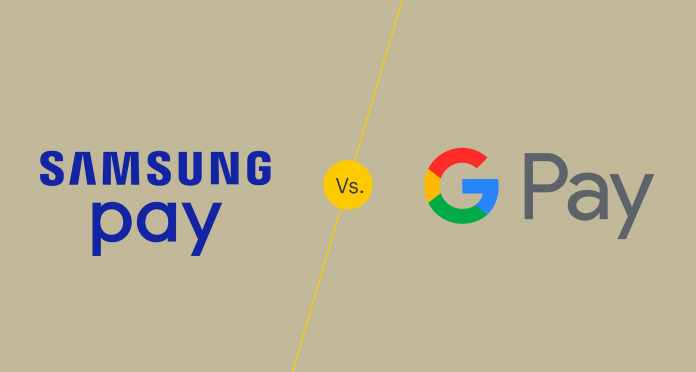The Digital wallet has gained exceptional popularity in recent times. There are many digital wallet services available in the market. Some big giants such as Samsung, Google, and Apple compete to grab the lion share of the digital wallet market. Today we will discuss Google pay vs Samsung pay. You will get a clear idea about the pros and cons of Samsung pay vs Google pay.
Digital wallets use in every sector, from product payment to app purchase payment from various app stores. Nowadays, people are less attracted to keeping a big chunk of cash with them.
So, let’s get in a comprehensive comparison of Google Pay vs Samsung Pay. We discussed all the pros and cons of these digital payment systems. After reading this article, you will get complete about two different payment getaways,
You may have found out about either of the significant contactless installment suppliers on Android, Google Pay, and Samsung Pay. However, you may be comfortable with what makes each particular. While both offer a similar essential tap-to-pay NFC usefulness, there are a few contrasts in their usability, upheld for substitute contactless installment norms, and the applications themselves. Here’s the way to sort out which one is best for you.
Table of Contents
Google Pay vs Samsung Pay
I caught myself thinking we make so quickly get use to the benefits of the civilization of every slightest deprivation of them. It becomes at least a nuisance that reduces the quality of life by creating inconveniences, sometimes foolish, sometimes tangible. It’s like the annual shutdown of hot water for two weeks in one progressive nuclear power … Not fatal, but incomprehensible and unpleasant.
I force to think about this by a routine visit to a grocery store. Only at the checkout, two people before payment, I learned that there were some problems with the Internet connection at the terminals, and you can pay for purchases only in cash.
With regret, I put my phone in my pocket. It prepares for payment out of habit and figured if I had enough cash to pay for everything I typed in the basket. The money was just right back to back by a lucky coincidence, and nothing had to be returned to the shelves or left at the checkout.
Leaving the store, I thought about which payment system I use and why.
Since the Galaxy S7, I have used Samsung Pay and found it convenient and meeting all my requirements as a fan of Samsung smartphones. In parallel, I tried to use Google Pay, comparing them with each other. Unfortunately, due to some circumstances (a smartphone is needed for business, and not just surfing the Internet), there was no opportunity to try Apple Pay, so today – about two payment systems, or instead, about their comparison and the reasons for choosing the final use case.
Before starting, I must make a small remark. Everything describes the subjective opinion of a single author: me, and does not claim to be the ultimate truth. My needs and the peculiarities of the world’s perception pushed me to the final choice. For you, these reasons may be just as essential or be something that is generally not worth paying attention to.
So what does Samsung Pay offer us?
Samsung Pay
One thing you need to remember, Samsung Pay only works with Samsung smartphones. You can’t use Samsung to pay with other companies’ smartphones. Samsung allows us to use many things at the same time, such as debit and credit cards, gift cards, and PayPal at the same time. It becomes all in one digital payment gateway.
Another interesting feature I found interesting, Samsung Pay supports MST technology. MST technology is quite old, and most of the company abandon the technology. But still, Samsung Pay supports it, in case if you ever need it.
Simultaneously, SPay permits you to store and use bank (charge and Visas) and dependability cards, blessing and club cards, and connection your PayPal account.
Another extremely noteworthy, however, step by step, losing its pertinence is the MST (Magnetic Secure Transmission) innovation, which permits you to pay even on old terminals that are not outfitted with a contactless installment module.
MST helped me out commonly utilize contactless installments of old terminals utilize in numerous stores.
The vendors’ eyes, who for a moment affirmed that it was difficult to pay by telephone in their store, however now watching a delivered look at the fly of the sales register, is inestimable.
Notwithstanding, right now, the innovation has lost its pertinence, since numerous retail outlets are refreshing securing arrangements and with them old terminals for new ones that help contactless installments.
A roundabout affirmation of this was the way that Samsung has quit furnishing mid-range models with this innovation.
Notwithstanding these undeniable preferences, there are additionally non-clear ones – SPay offers diverse faithfulness programs in different nations. This implies by introducing, for instance, the American adaptation of SPay (utilizing the concentration with changing the district in the firmware), you can gain admittance to the reward program, where extra focuses are granted for each buy. These focuses can be spent on online endorsements for Samsung items (you need a US address to get them) or play the wheel of fortune, where you can likewise win money prizes.
Although it has many advantages, it also has some cons you need to remember. Just giving you an example, you can’t add ten bank cards in one Samsung Pay digital wallet. Samsung is super protective of digital payment security. To ensure maximum security, they don’t allow to add more than 10 Bank cards. To make a payment, you have to enter into the Samsung pay with your password or fingerprint scanner.
Among different limitations (even though for some it will end up being an or more), it merits featuring Samsung’s jumpy worry about the security of installments. In this way, to pay for your buy, you won’t just need to dispatch SPay, yet you will likewise need to affirm the exchange with either a secret phrase, a unique mark, or an iris of the eye.
Also, this approval strategy doesn’t depend on any capacity on the one that you have on.
They are hindering the telephone itself.
From one perspective, it protects and adds genuine feelings of serenity to the proprietor; then again, it makes burdens with extra body developments.
Be that as it may, SPay can be arranged to dispatch from any screen, even from a bolted screen off, with a basic swipe up from the screen’s base edge.
This can be extremely advantageous and altogether accelerates the installment cycle. You can also pick where to leave the swipe and eliminate it (home screen, lock screen, screen off).
Now about Google Pay (from now on GPay).
Google pay does not support the NFC system, unlike Samsung pay. So, if you are in a place where they use old terminal technology, Google pay cannot help you. In this case, you have to make payment either in cash or with your bank card. But, Google pay does not restrict users how many cuts they can use in one Google pay service. They are quite flexible in this regard, unlike Samsung pay.
Another significant information to share with our readers; Google pay can use on any smartphone. They don’t put any restrictions on it. As you said earlier, Samsung does not let other smartphone manufacturing companies use their technology. Google pay supports an older version of Android devices and works perfectly with the iPhone.
Similar to SPay, loyalty cards can add to GPay.
Thus, Google’s payment service is much more versatile than Samsung’s.
For better or worse, Google is not so much concerned about payment security. Therefore, unlike Samsung, Google’s payment system uses the same phone locks as the phone itself. That is, if you use a fingerprint and unlock your phone before paying, you don’t have to confirm your purchase. An additional plus is that there is no need to launch GPay – to pay separately, you need to bring the unlocked phone to the terminal.
On the one hand, it is not as secure as in SPay; on the other hand, if someone unlocked my phone, what prevents them from doing the same with the payment application?
In total, we have the following:
SPay allows you to pay even where there is no support for contactless payments. Still, it works only on Samsung devices (except for budget ones). It has an increased security level, which is often unnecessary, as it creates additional inconveniences (the fingerprint does not work immediately, the retina scanner requires you to take off your glasses and spread your eyes).
GPay does not have any hardware manufacturer restrictions and works on any Android device that meets several requirements, such as version and no modifications, and has a comfortable security level. Simultaneously, unlike its counterpart, it allows you to pay only on terminals with NFC support.
Instead of a conclusion-
In my case, the most optimal option turned out to be using two payment systems at once, organically complementing each other.
As my primary payment method, I use GPay, which allows you to pay for purchases from the lock screen by pressing the power key once since the phone uses Smart Lock, unlocking the phone while connected to the fitness bracelet. This turns out to be very convenient – you do not need to press anything, enter, etc. I just hit the power key, held up my phone, and voila, the payment went through.
In parallel, SPay is configured on the phone, used in cases where GPay cannot be paid (for example, a terminal without NFC support). To ensure that the services do not interfere with each other, SPay is installed as a backup and is configured to start only from the lock screen with a swipe up. The rest of the time, he sleeps and waits in the wings.
One of the frequent times SPay comes in handy is buying snacks from the vending machine at work.
The fact is that a blunt terminal is installed in this machine, which does not always process contactless cards correctly, and then it refuses to accept the phone and asks to insert or swipe the card. This is where SPay comes in with his MST. Instead of a card, I launch SPay and hold my phone up to the terminal’s magnetic reader. The airport thinks a card with a magnetic stripe swipe through it and happily agrees to accept payment.
Of course, besides this humorous scenario, SPay comes in very handy when travelling to European countries. Where not all terminals are equipped with NFC chips.
Soon I plan to switch from Samsung devices to Google Pixel devices. I will not have a choice which payment system to use, but Samsung owners have a choice.
In this regard, I would like to know your scenarios for using GPay / SPay / Apple Pay and preferences in choosing contactless payment systems.
I hope you know you have a clear understanding of Google pay and Samsung Pay. Which one is better and why in your personal opinion. Comment on us and let us share your thoughts.








